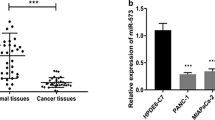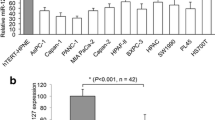Abstract
Background
The regulation of Mut L homologue 1 (MLH1) expression by microRNA (miR)-155 and its prognostic significance in pancreatic cancer (PC) remain to be elucidated. This study aimed to address the issues.
Methods
MiR-155 mimics and inhibitor were transfected to PC cell lines, Panc-1 and Capan-1. Expression of MLH1 was subsequently evaluated. Then, luciferase activity was detected after miR-155 mimics and pRL-TK plasmids containing wild-type and mutant 3′UTRs of MLH1 mRNA were co-transfected. Finally, immunohistochemical staining for MLH1 was performed in PC samples.
Results
Transfection of miR-155 mimics and inhibitor led to reversely altered protein expressions of miR-155 and MLH1, whereas the corresponding mRNA expressions were similar. A significant decrease in luciferase activity in the cells transfected with the wild-type pRL-TK plasmid was shown in contrast to those transfected with the mutant one. In addition, MLH1 was less expressed in tumor than in para-tumor tissues of PC. Extensive MLH1 expression was significantly associated with favorable differentiation and less lymph node metastasis. MLH1 expression was found to be a prognosticator in univariate analysis, and being of marginally significant impact in multivariate test.
Conclusions
MLH1 might serve as a direct target of miR-155 and a potential prognosis predictor in PC.


Similar content being viewed by others
References
Hidalgo M. Pancreatic cancer. N Engl J Med. 2010; 362: 1605–17.
Martin SA, Lord CJ, Ashworth A. Therapeutic targeting of the DNA mismatch repair pathway. Clin Cancer Res. 2010; 16: 5107–13.
Mackay HJ, Cameron D, Rahilly M, et al. Reduced MLH1 expression in breast tumors after primary chemotherapy predicts disease-free survival. J Clin Oncol. 2000; 18: 87–93.
Kruschewski M, Noske A, Haier J, et al. Is reduced expression of mismatch repair genes MLH1 and MSH2 in patients with sporadic colorectal cancer related to their prognosis? Clin Exp Metastasis. 2002; 19: 71–7.
Kishi K, Doki Y, Yano M, et al. Reduced MLH1 expression after chemotherapy is an indicator for poor prognosis in esophageal cancers. Clin Cancer Res. 2003; 9: 4368–75.
Uehara H, Miyamoto M, Kato K, et al. Deficiency of hMLH1 and hMSH2 expression is a poor prognostic factor in esophageal squamous cell carcinoma. J Surg Oncol. 2005; 92: 109–15.
Seng TJ, Currey N, Cooper WA, et al. DLEC1 and MLH1 promoter methylation are associated with poor prognosis in non-small cell lung carcinoma. Br J Cancer. 2008; 99: 375–82.
Sinha S, Singh RK, Alam N, et al. Frequent alterations of hMLH1 and RBSP3/HYA22 at chromosomal 3p22.3 region in early and late-onset breast carcinoma: clinical and prognostic significance. Cancer Sci. 2008; 99: 1984–91.
Ghosh A, Ghosh S, Maiti GP, et al. Frequent alterations of the candidate genes hMLH1, ITGA9 and RBSP3 in early dysplastic lesions of head and neck: clinical and prognostic significance. Cancer Sci. 2010; 101: 1511–20.
Smyth EF, Sharma A, Sivarajasingham N, et al. Prognostic implications of hMLH1 and p53 immunohistochemical status in right-sided colon cancer. Dis Colon Rectum. 2004; 47: 2086–91.
Ju W, Park HM, Lee SN, et al. Loss of hMLH1 expression is associated with less aggressive clinicopathological features in sporadic endometrioid endometrial adenocarcinoma. J Obstet Gynaecol Res. 2006; 32: 454–60.
Ide T, Kitajima Y, Ohtaka K, et al. Expression of the hMLH1 gene is a possible predictor for the clinical response to 5-fluorouracil after a surgical resection in colorectal cancer. Oncol Rep. 2008; 19: 1571–6.
Valeri N, Gasparini P, Fabbri M, et al. Modulation of mismatch repair and genomic stability by miR-155. Proc Natl Acad Sci U S A. 2010; 107: 6982–7.
Duriseti S, Winnard PT Jr, Mironchik Y, et al. HOXA5 regulates hMLH1 expression in breast cancer cells. Neoplasia. 2006; 8: 250–8.
Nakamura H, Tanimoto K, Hiyama K, et al. Human mismatch repair gene, MLH1, is transcriptionally repressed by the hypoxia-inducible transcription factors, DEC1 and DEC2. Oncogene. 2008; 27: 4200–9.
Edwards RA, Witherspoon M, Wang K, et al. Epigenetic repression of DNA mismatch repair by inflammation and hypoxia in inflammatory bowel disease-associated colorectal cancer. Cancer Res. 2009; 69: 6423–9.
Kondo E, Furukawa T, Yoshinaga K, et al. Not hMSH2 but hMLH1 is frequently silenced by hypermethylation in endometrial cancer but rarely silenced in pancreatic cancer with microsatellite instability. Int J Oncol. 2000; 17: 535–41.
Tomaszewska R, Okoń K, Stachura J. Expression of the DNA mismatch repair proteins (hMLH1 and hMSH2) in infiltrating pancreatic cancer and its relation to some phenotypic features. Pol J Pathol. 2003; 54: 31–7.
Maple JT, Smyrk TC, Boardman LA, et al. Defective DNA mismatch repair in long-term (> or =3 years) survivors with pancreatic cancer. Pancreatology. 2005; 5: 220–7.
Bergmann F, Aulmann S, Wente MN, et al. Molecular characterisation of pancreatic ductal adenocarcinoma in patients under 40. J Clin Pathol. 2006; 59: 580–4.
Nakata B, Wang YQ, Yashiro M, et al. Negative hMSH2 protein expression in pancreatic carcinoma may predict a better prognosis of patients. Oncol Rep. 2003; 10: 997–1000.
LaConti JJ, Shivapurkar N, Preet A, et al. Tissue and serum microRNAs in the Kras(G12D) transgenic animal model and in patients with pancreatic cancer. PLoS One. 2011; 6: e20687.
Catto JW, Xinarianos G, Burton JL, et al. Differential expression of hMLH1 and hMSH2 is related to bladder cancer grade, stage and prognosis but not microsatellite instability. Int J Cancer. 2003; 105: 484–90.
Lazaris AC, Zarogiannos A, Kavantzas N, et al. MLH1 mismatch repair gene product is associated with apoptotic potential of urothelial bladder carcinomas. Anticancer Res. 2006; 26: 1535–42.
Vilar E, Scaltriti M, Balmaña J, et al. Microsatellite instability due to hMLH1 deficiency is associated with increased cytotoxicity to irinotecan in human colorectal cancer cell lines. Br J Cancer. 2008; 99: 1607–12.
Ding X, Mohd AB, Huang Z, et al. MLH1 expression sensitises ovarian cancer cells to cell death mediated by XIAP inhibition. Br J Cancer. 2009; 101: 269–77.
Collins SL, Hervé R, Keevil CW, et al. Down-regulation of DNA mismatch repair enhances initiation and growth of neuroblastoma and brain tumour multicellular spheroids. PLoS One. 2011; 6: e28123.
Bartel DP. MicroRNAs: genomics, biogenesis, mechanism, and function. Cell. 2004; 116: 281–97.
Lee EJ, Gusev Y, Jiang J, et al. Expression profiling identifies microRNA signature in pancreatic cancer. Int J Cancer. 2007; 120: 1046–54.
Ali S, Banerjee S, Logna F, et al. Inactivation of Ink4a/Arf leads to deregulated expression of miRNAs in K-Ras transgenic mouse model of pancreatic cancer. J Cell Physiol. 2012; 227: 3373–80.
Gironella M, Seux M, Xie MJ, et al. Tumor protein 53-induced nuclear protein 1 expression is repressed by miR-155, and its restoration inhibits pancreatic tumor development. Proc Natl Acad Sci U S A. 2007; 104: 16170–5.
Perini MV, Montagnini AL, Jukemura J, et al. Clinical and pathologic prognostic factors for curative resection for pancreatic cancer. HPB (Oxford). 2008; 10: 356–62.
Sahin TT, Fujii T, Kanda M, et al. Prognostic implications of lymph node metastases in carcinoma of the body and tail of the pancreas. Pancreas. 2011; 40: 1029–33.
Ansari D, Rosendahl A, Elebro J, et al. Systematic review of immunohistochemical biomarkers to identify prognostic subgroups of patients with pancreatic cancer. Br J Surg. 2011; 98: 1041–55.
Greither T, Grochola LF, Udelnow A, et al. Elevated expression of microRNAs 155, 203, 210 and 222 in pancreatic tumors is associated with poorer survival. Int J Cancer. 2010; 126: 73–80.
Acknowledgments
This study was supported by the National Laboratory of Molecular Biology Special Foundation (2060204), Beijing Municipal Natural Science Foundation (7100003), and research special fund for public welfare industry of health (201202007), China.
Author information
Authors and Affiliations
Corresponding author
Rights and permissions
About this article
Cite this article
Liu, WJ., Zhao, YP., Zhang, TP. et al. MLH1 as a Direct Target of MiR-155 and a Potential Predictor of Favorable Prognosis in Pancreatic Cancer. J Gastrointest Surg 17, 1399–1405 (2013). https://doi.org/10.1007/s11605-013-2230-5
Received:
Accepted:
Published:
Issue Date:
DOI: https://doi.org/10.1007/s11605-013-2230-5




